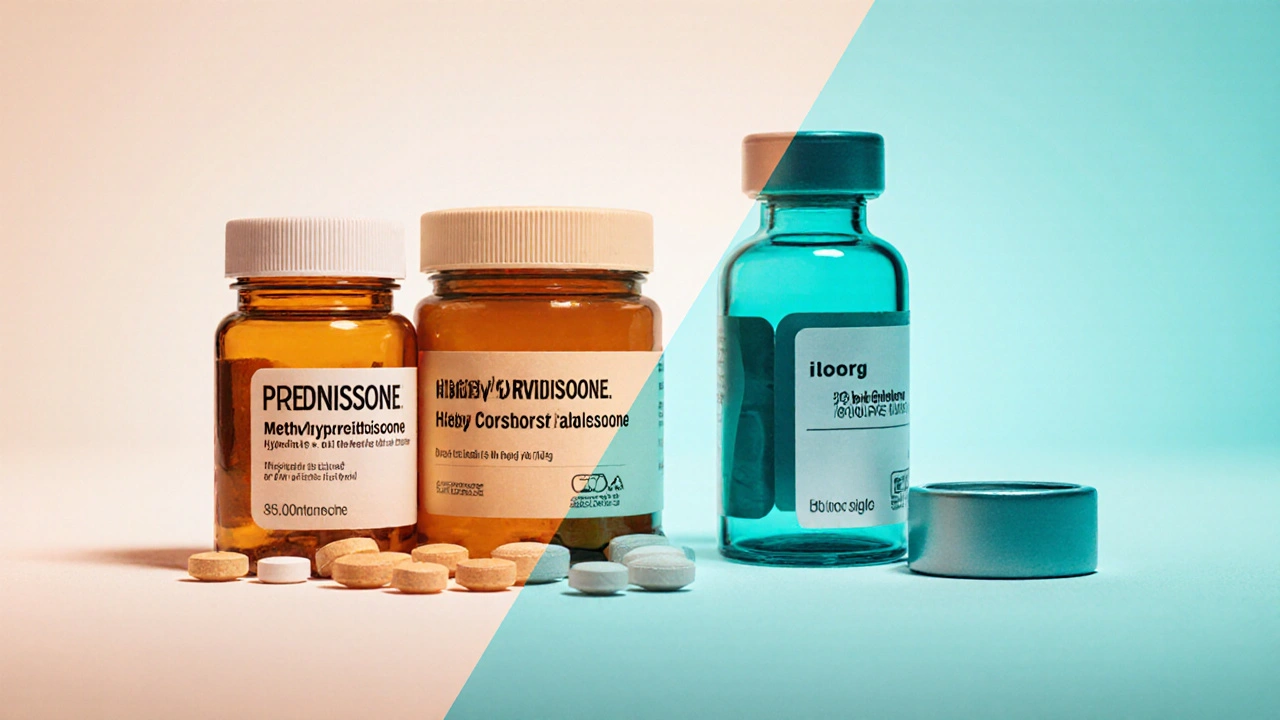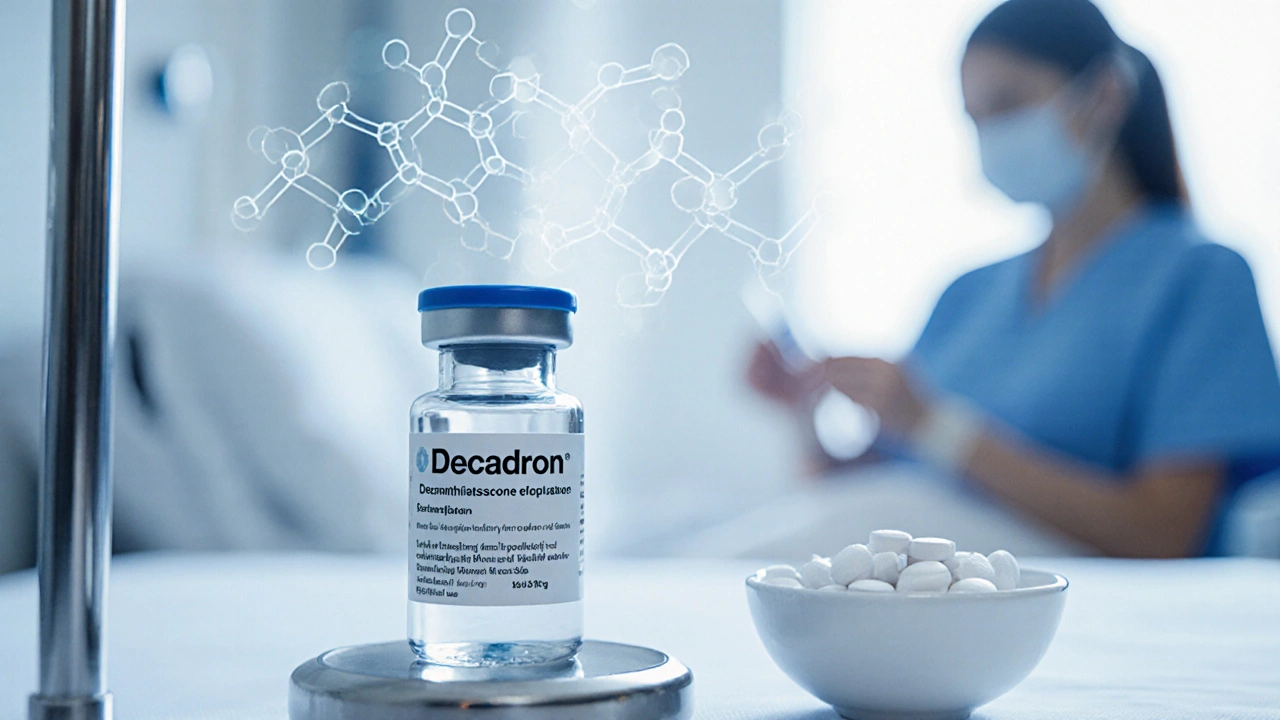Steroid Comparison Selector
Recommended Treatment Option:
Select your conditions and click "Compare Options" to get personalized recommendations.
Drug Comparison Overview
Potency: 25-30x hydrocortisone
Half-life: 36-72 hours
Use: Severe acute inflammation, brain edema
Potency: 4-5x hydrocortisone
Half-life: 12-36 hours
Use: Chronic autoimmune diseases
Potency: 5-6x hydrocortisone
Half-life: 18-36 hours
Use: Acute flare-ups
Mechanism: COX inhibition
Half-life: 2-4 hours
Use: Mild-moderate inflammation
When you or a loved one need a fast‑acting anti‑inflammatory drug, the name Decadron often pops up. But is it always the best choice? This article breaks down what Decadron (dexamethasone) actually is, when doctors prescribe it, and how it stacks up against the most common alternatives - from other corticosteroids to non‑steroidal options. By the end you’ll know which drug fits your health situation and how to avoid the pitfalls that come with powerful steroids.
Key Takeaways
- Decadron is a high‑potency synthetic corticosteroid used for severe inflammation, allergic reactions, and certain cancers.
- Its main rivals - prednisone, methylprednisolone, hydrocortisone, and betamethasone - differ in strength, duration, and side‑effect profile.
- Non‑steroidal anti‑inflammatory drugs (NSAIDs) and biologic agents offer steroid‑free routes for mild‑to‑moderate inflammation.
- Choosing the right drug hinges on the condition being treated, dosage length, and personal risk factors such as diabetes or osteoporosis.
- Safe use means tapering, monitoring blood sugar, and pairing with calcium/vitaminD when long‑term therapy is unavoidable.
What Is Decadron?
Decadron is the brand name for dexamethasone, a synthetic corticosteroid with strong anti‑inflammatory and immunosuppressive properties. It was first approved in the 1960s and quickly became a go‑to for doctors because it works faster and lasts longer than many older steroids.
How Decadron Works
Dexamethasone binds to glucocorticoid receptors in almost every cell, turning off genes that make inflammatory proteins (like cytokines) and turning on genes that help stabilize cell membranes. The result is a rapid drop in swelling, pain, and immune activity. Because it is a corticosteroid a class of steroid hormones that mimic the body’s natural cortisol, it also influences metabolism, blood‑sugar regulation, and bone turnover.
Typical Uses and Dosage Forms
Doctors prescribe Decadron for a wide range of problems, including:
- Severe allergic reactions (e.g., anaphylaxis adjunct therapy)
- Acute asthma exacerbations
- Brain edema from tumors or head injury
- Autoimmune disorders such as lupus flares
- Chemotherapy‑induced nausea and vomiting control
It’s available as oral tablets (0.5mg, 4mg, 6mg), injectable solutions, and ophthalmic drops. Dosage varies drastically - from a single 10mg IV bolus for an allergic crisis to a tapering course of 0.5‑2mg per day for chronic conditions.

Major Side Effects to Watch
Because Decadron is a high‑potency steroid, it carries a heavier side‑effect baggage than milder alternatives. Common issues include:
- Elevated blood glucose, which can trigger or worsen diabetes
- Weight gain and fluid retention
- Increased risk of infection (the drug suppresses the immune system)
- Osteoporosis with prolonged use, especially in older adults
- Mood swings, insomnia, or even psychosis at very high doses
Long‑term users often need calcium, vitaminD, and bone‑density monitoring. Short bursts (≤2weeks) are usually safe for most people, but the drug should never be stopped abruptly after a long taper - a gradual reduction prevents adrenal insufficiency.
Alternative Corticosteroids
If Decadron feels too strong, doctors may reach for a less potent steroid. Here are the most frequently used alternatives:
Prednisone is a mid‑strength oral corticosteroid that is often the first line for chronic inflammation such as rheumatoid arthritis.
Methylprednisolone offers a slightly higher potency than prednisone and is available in oral and IV forms, making it popular for acute flare‑ups.
Hydrocortisone mirrors the body’s natural cortisol level, so it’s the mildest option and frequently used for adrenal insufficiency or mild skin inflammation.
Betamethasone is similar in strength to Decadron but is most often found in topical creams for eczema or psoriasis rather than systemic use.
All of these share the same basic mechanism (glucocorticoid receptor activation) but differ in half‑life, potency, and how long they stay active in the body.
Non‑Steroid Alternatives
When the goal is to avoid steroids altogether, doctors may turn to other drug classes:
NSAIDs such as ibuprofen, naproxen, or celecoxib work by blocking cyclooxygenase enzymes, reducing prostaglandin‑mediated inflammation without suppressing the immune system.
Biologics (e.g., adalimumab, etanercept) target specific immune pathways and are used for moderate‑to‑severe autoimmune diseases when steroids are contraindicated.
These alternatives can be safer for long‑term management but may be slower to act and often cost more.
Side‑by‑Side Comparison
| Parameter | Decadron (Dexamethasone) | Prednisone | Methylprednisolone | Hydrocortisone | NSAIDs (Ibuprofen) |
|---|---|---|---|---|---|
| Potency (relative to hydrocortisone) | 25‑30× | 4‑5× | 5‑6× | 1× (baseline) | Not a steroid - works via COX inhibition |
| Onset of action | 30‑60min (IV), 2‑4h (oral) | 1‑2h (oral) | 30‑60min (IV), 3‑4h (oral) | 2‑3h (oral) | 30‑60min (oral) |
| Half‑life | 36‑72h | 12‑36h | 18‑36h | 8‑12h | 2‑4h |
| Typical short‑term dose | 0.5‑6mg/day | 5‑60mg/day | 4‑48mg/day | 20‑240mg/day | 200‑800mg/day divided |
| Key side‑effects | High blood sugar, osteoporosis, mood changes | Weight gain, hypertension, cataracts (long‑term) | Similar to prednisone, slightly higher infection risk | Fluid retention, mild adrenal suppression | GI bleeding, kidney injury, cardiovascular risk |
| Best for | Severe, acute inflammation or cerebral edema | Chronic autoimmune diseases | Acute flare‑ups needing rapid control | Physiologic cortisol replacement | Mild‑to‑moderate pain/inflammation without immunosuppression |

How to Choose the Right Option
Think of the decision as a balance between potency and safety. Follow these quick checks:
- Urgency: If you need a response within minutes (e.g., brain swelling), Decadron or IV methylprednisolone wins.
- Duration: For treatment lasting weeks to months, pick a milder steroid (prednisone) or a non‑steroid if possible.
- Comorbidities: Diabetes, osteoporosis, or psychiatric history push you toward the lowest effective dose or an NSAID/biologic route.
- Cost & access: Generic prednisone and hydrocortisone are cheap; biologics can be pricey and require specialist monitoring.
Always discuss the plan with your prescriber and ask about a tapering schedule if the course exceeds a few days.
Practical Tips for Safe Use
- Never stop a high‑dose steroid abruptly - taper gradually to let your adrenal glands recover.
- Check blood sugar at least twice a week if you have diabetes; steroids can spike glucose quickly.
- Take calcium (1,000mg) and vitaminD (800IU) daily when you anticipate more than two weeks of therapy.
- Stay hydrated and avoid high‑salt meals to limit fluid retention.
- If you notice mood swings, insomnia, or unusual euphoria, call your doctor - dose adjustment may be needed.
Frequently Asked Questions
Can I use Decadron for a mild headache?
Usually not. Decadron’s strength is overkill for a typical headache and brings unnecessary side‑effects. An NSAID or acetaminophen is safer unless a doctor specifically orders the steroid for a rare inflammatory cause.
How long can I stay on Decadron?
Short bursts (a few days to two weeks) are common for acute situations. For longer courses, doctors usually switch to a milder steroid like prednisone and add bone‑protective supplements.
Is prednisone safer than Decadron?
Prednisone is less potent, so it generally carries a lower risk of severe blood‑sugar spikes and mood changes. However, it still can cause weight gain, hypertension, and bone loss if used long‑term.
When should I consider a non‑steroid like an NSAID instead?
If your inflammation is mild‑to‑moderate, the cause is not life‑threatening, and you have no stomach or kidney issues, an NSAID often provides sufficient relief without the immunosuppressive effects of steroids.
Can Decadron interact with other medications?
Yes. It can boost the effect of blood‑thinners (like warfarin), raise blood sugar when taken with diabetes meds, and reduce the efficacy of certain vaccines. Always list all current drugs with your prescriber.
Next Steps & Troubleshooting
If you’ve been prescribed Decadron, start by confirming the dosage, route, and taper plan in writing. Track any new symptoms - especially mood changes or rapid weight gain - and report them immediately. If side‑effects become intolerable, ask your doctor about switching to prednisone or an NSAID, depending on why you started the steroid.
For chronic conditions, consider a multidisciplinary approach: a rheumatologist for autoimmune disease, an endocrinologist for steroid‑induced diabetes, and a physiotherapist for joint health. Combining lifestyle tweaks (low‑salt diet, weight‑bearing exercise) with the right medication can often lower the needed steroid dose, keeping you safer in the long run.

Anthony Palmowski
Decadron is a powerhouse steroid!!! If you’re not tracking glucose EVERY SINGLE DAY you’re basically flirting with a diabetes diagnosis!!! The hype about “quick relief” is fine, but the side‑effect profile is a nightmare if you ignore it!!!
Jillian Rooney
i really think people should be more careful about using such strong meds, especially when there are milder options out there… it's just common sense to think about long term health.
Rex Peterson
From an epistemological standpoint, the decision to employ dexamethasone necessitates a deliberation of both ontological risk and therapeutic necessity. One must weigh the ontic reality of inflammatory pathology against the potential for iatrogenic sequelae, such as hyperglycemia and osteopenia. The principle of beneficence obliges the clinician to choose the least harmful means to achieve clinical remission, whereas non‑maleficence warns against gratuitous exposure to high‑potency glucocorticoids. Moreover, the autonomy of the patient demands informed consent rooted in transparent exposition of these trade‑offs. Ultimately, the judicious use of Decadron reflects a balance between the imperatives of immediate physiological restoration and the preservation of long‑term homeostasis.
Candace Jones
Decadron works fast, but you still need a taper plan to avoid adrenal suppression. Pair it with calcium and vitamin D if you’ll be on it more than two weeks.
Robert Ortega
Both steroids and NSAIDs have their place; matching the drug to the severity of inflammation is key.
Elizabeth Nisbet
Hey, if you’re worried about blood sugar spikes, try monitoring your levels twice daily and keep a low‑carb snack handy-helps keep things steady while you’re on the taper.
Sydney Tammarine
Oh dear, the tragedy of a poor soul daring to dabble with dexamethasone without a proper protocol! 😱 One minute you’re feeling heroic, the next you’re drowning in cortisol‑induced chaos. Let’s not romanticize the danger, shall we?
josue rosa
In clinical pharmacodynamics, dexamethasone’s high glucocorticoid receptor affinity translates into a pronounced transcriptional repression of pro‑inflammatory cytokines such as IL‑1β, TNF‑α, and IL‑6. Consequently, the downstream attenuation of the NF‑κB signaling cascade yields rapid edema resolution, which is particularly advantageous in neuro‑oncologic settings where intracranial pressure must be controlled expediently. However, the pharmacokinetic profile-characterized by a 36‑72‑hour elimination half‑life-necessitates vigilant monitoring for iatrogenic hyperglycemia, osteoclastic activity, and hypothalamic‑pituitary‑adrenal axis suppression. Therapeutic drug monitoring, albeit not routinely performed for steroids, can be approximated through serial measurement of fasting glucose, serum calcium, and bone turnover markers. When prescribing, a risk‑benefit algorithm that integrates patient‑specific comorbidities-such as pre‑existing diabetes mellitus, osteopenia, or psychiatric history-should be employed to mitigate adverse outcomes. Moreover, prophylactic adjuncts including bisphosphonates, vitamin D supplementation, and mood‑stabilizing agents may be warranted in high‑risk cohorts. It is incumbent upon the prescriber to devise a tapering schedule that gradually reduces glucocorticoid exposure, thereby allowing endogenous cortisol synthesis to recover and preventing adrenal crisis.
Shawn Simms
It is imperative that clinicians adhere to established guidelines when initiating dexamethasone therapy; deviation from recommended dosing regimens can result in preventable complications.
Geneva Angeles
Choosing the right anti‑inflammatory agent is like navigating a complex maze, but with a clear roadmap you can emerge unscathed. First, assess the urgency of the condition: life‑threatening cerebral edema demands the rapid, potent action of dexamethasone, whereas a mild tendonitis might be soothed by an over‑the‑counter NSAID. Next, consider the duration of therapy; short bursts of high‑potency steroids are generally safe, but prolonged exposure invites metabolic and skeletal side‑effects. Third, evaluate patient‑specific risk factors such as diabetes, osteoporosis, or a history of mood disorders-these comorbidities tip the balance toward milder steroids or non‑steroidal options. Fourth, factor in cost and accessibility; generic prednisone is inexpensive and widely available, while biologics can be prohibitively pricey. Fifth, engage the patient in shared decision‑making; informed consent empowers them to monitor blood glucose, watch for weight changes, and report mood fluctuations early. Sixth, establish a tapering protocol when the steroid course exceeds a few days, thereby protecting adrenal function. Seventh, supplement long‑term steroid users with calcium and vitamin D to safeguard bone health. Eighth, schedule periodic labs-fasting glucose, blood pressure, and bone density scans-to catch adverse trends before they become problematic. Ninth, stay up‑to‑date with evolving clinical guidelines, as new evidence may shift the risk‑benefit calculus. Tenth, remember that lifestyle modifications-balanced diet, regular weight‑bearing exercise, and stress reduction-can reduce reliance on pharmacologic interventions. Eleventh, consult specialists when complex autoimmune diseases are involved; rheumatologists and endocrinologists bring invaluable expertise. Twelfth, document every dosage change meticulously to avoid dosing errors. Thirteenth, be aware of drug‑drug interactions, especially with anticoagulants and diabetes medications. Fourteenth, educate caregivers about the signs of adrenal insufficiency, such as profound fatigue, nausea, and hypotension. Finally, maintain a hopeful outlook; with thoughtful selection and vigilant monitoring, patients can achieve symptom relief while minimizing the pitfalls of powerful steroids.
Scott Shubitz
Holy moly, if you think swapping Decadron for a plain ibuprofen will save you from catastrophic side‑effects, you’re living in a fantasy world-a steroid’s fire‑power is unmatched when the body’s in flames!
Soumen Bhowmic
When we sit down as a multidisciplinary team-taking input from the primary care physician, the endocrinologist, and the pharmacist-we can construct a nuanced plan that balances therapeutic efficacy with safety. For instance, if a patient presents with acute asthma exacerbation, we might start with a short‑acting beta‑agonist, add a systemic corticosteroid like dexamethasone for rapid inflammation control, and then transition to an inhaled steroid for maintenance. Meanwhile, we’d advise the patient to monitor blood glucose daily, schedule a bone density scan in six months, and consider prophylactic calcium/vitamin D supplementation. By involving the patient in each step, we empower them to recognize early warning signs and adhere to the taper schedule, ultimately reducing the likelihood of adrenal suppression. This collaborative model not only optimizes outcomes but also fosters trust among all parties involved.
Jenna Michel
Quick tip: when prescribing dexamethasone, align the dosing interval with the drug’s half‑life (≈48 h) to maintain steady‑state plasma concentrations-this pharmacokinetic principle helps avoid peaks that trigger hyperglycemia.
Abby Richards
Great summary! 👍 Just remember to double‑check spelling of “dexamethasone” before you hit send.
Lauren Taylor
In the broader context of anti‑inflammatory pharmacotherapy, it is essential to appreciate the mechanistic diversity among agents, ranging from the genomic actions of glucocorticoids to the enzymatic inhibition of cyclooxygenases by NSAIDs. By fostering an inclusive dialogue that welcomes perspectives from both seasoned clinicians and emerging trainees, we can collectively deepen our understanding of how these medications intersect with patient‑specific factors such: comorbid metabolic syndrome, genetic polymorphisms affecting drug metabolism, and socioeconomic determinants of health. This holistic approach not only enriches our clinical reasoning but also promotes equitable care delivery across diverse populations.
Vanessa Guimarães
Of course, the pharma giants want us all glued to their steroid pipelines while they hide the natural alternatives-if you read between the lines, it’s a textbook case of engineered dependency.
Lee Llewellyn
While everyone seems to sing praises of dexamethasone for its rapid anti‑inflammatory prowess, let’s not forget that the same potency that quells cerebral edema also wreaks havoc on glucose metabolism, bone turnover, and even mood regulation; in other words, the drug is a double‑edged sword that many prefer to brandish without acknowledging the collateral damage, which, frankly, is a rather negligent stance for any responsible prescriber.
Drew Chislett
Stay informed, stay safe, and keep questioning your meds!